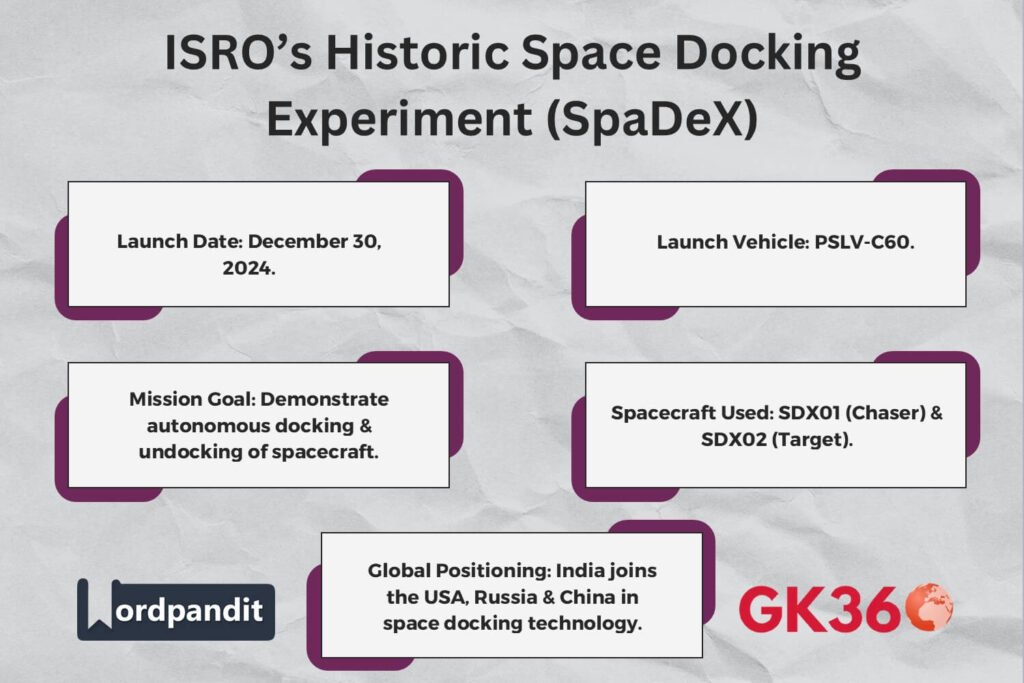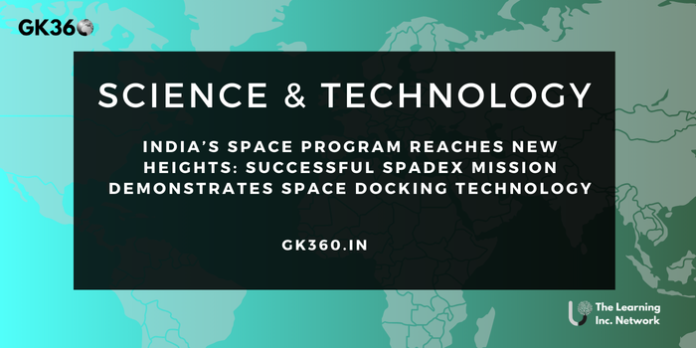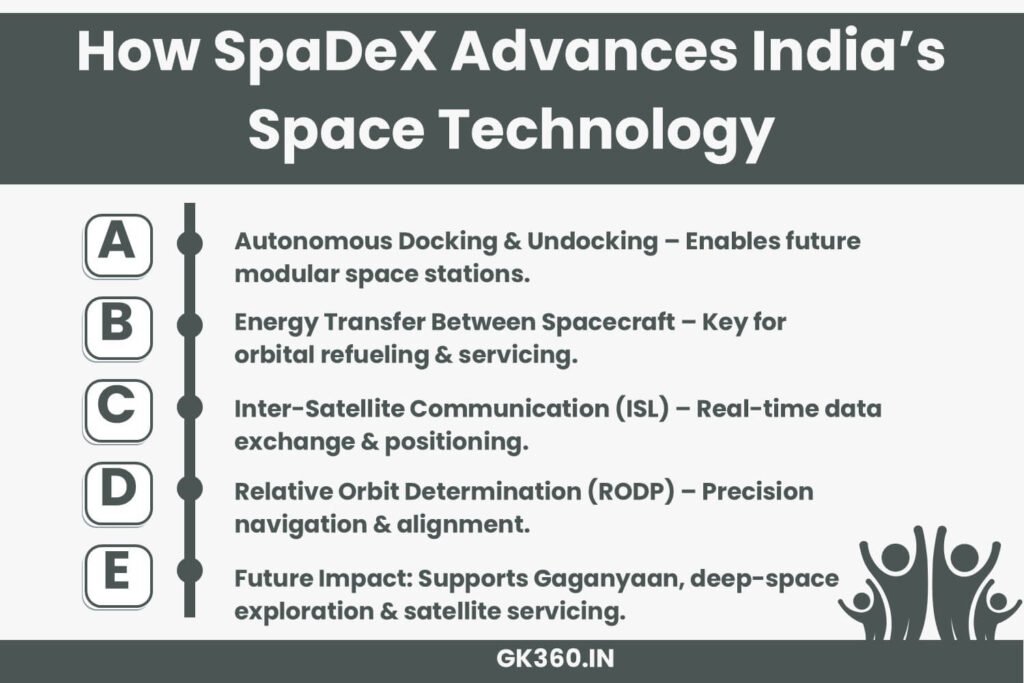India’s Space Docking Experiment (SpaDeX): ISRO’s Breakthrough in Autonomous Space Technology
Introduction: India’s Space Docking Breakthrough
India’s space exploration program achieved a historic milestone with the successful launch of the Space Docking Experiment (SpaDeX) by the Indian Space Research Organisation (ISRO). On December 30, 2024, the Polar Satellite Launch Vehicle (PSLV-C60) carried two small spacecraft—SDX01 (Chaser) and SDX02 (Target)—into low-Earth orbit (LEO). This breakthrough places India alongside Russia, the United States, and China in demonstrating autonomous docking technology, a critical capability for advanced space missions.

Table of Contents
- What is SpaDeX? Mission Overview
- Objectives of SpaDeX: Advancing Autonomous Docking
- Key Technologies Used in SpaDeX
- Indigenous Technologies & Innovations
- Significance of SpaDeX for India’s Space Future
- Launch Details & Mission Timeline
- Future Space Missions & Global Collaborations
- Frequently Asked Questions (FAQs)
- Conclusion & The Road Ahead
What is SpaDeX? Mission Overview
SpaDeX is designed to develop and test the capability for autonomous rendezvous, docking, and undocking of spacecraft in space. This technology is essential for missions involving satellite servicing, space station construction, and future interplanetary exploration.
Objectives of SpaDeX: Advancing Autonomous Docking
The key objectives of SpaDeX include:
- Autonomous Docking and Undocking: Demonstrating the ability of two spacecraft to dock and undock without human intervention.
- Energy Transfer Between Spacecraft: Establishing a system for power transfer between docked spacecraft to enable future robotic servicing missions.
- Accurate Positioning and Navigation: Using Differential Global Navigation Satellite System (GNSS)-based Satellite Positioning for precise coordination.
Key Technologies Used in SpaDeX
Autonomous Docking & Undocking
ISRO successfully showcased a high-precision autonomous docking system, ensuring that spacecraft can operate independently without manual control.
Energy Transfer Between Spacecraft
A pioneering step toward orbital refueling and servicing, this experiment tested mechanisms to share power between docked spacecraft.
Precise Positioning & Navigation
By employing GNSS-based Relative Orbit Determination, ISRO ensured real-time alignment and precise maneuvering between the spacecraft.
Indigenous Technologies & Innovations
Advanced Docking Mechanism
ISRO engineers developed a custom docking system for small spacecraft, allowing for secure connections, energy transfer, and communication.
Inter-Satellite Communication Link (ISL)
A real-time data exchange system that enables seamless communication and synchronized maneuvering between the spacecraft.
Relative Orbit Determination and Propagation (RODP)
This system ensured that both spacecraft could navigate with exceptional accuracy during critical docking phases.
Significance of SpaDeX for India’s Space Future
- Enhanced Capabilities for Future Missions: Supports satellite servicing, modular space station assembly, and deep-space exploration.
- Global Recognition and Technological Leadership: Establishes India as a key player in autonomous space operations.
- Vision for Deep-Space Exploration: Lays the foundation for missions like Chandrayaan-4, which will operate independently of Earth-based navigation.
Launch Details & Mission Timeline
- Launch Date: December 30, 2024
- Launch Vehicle: PSLV-C60
- Launch Site: Satish Dhawan Space Centre (SDSC), Sriharikota
- Mission Control: ISRO Telemetry, Tracking, and Command Network (ISTRAC)
Future Space Missions & Global Collaborations
The success of SpaDeX is a stepping stone for India’s upcoming missions:
- NVS-02 Satellite Launch (January 2025): Strengthening India’s NavIC navigation system.
- Gaganyaan Mission: India’s first crewed spaceflight with docking capabilities.
- International Partnerships: Potential collaborations with NASA, ESA, and JAXA for deep-space projects.
Frequently Asked Questions (FAQs)
1. What is ISRO’s Space Docking Experiment (SpaDeX)?
SpaDeX is an autonomous docking technology demonstration mission by ISRO, testing key rendezvous and docking systems for future space operations.
2. Why is autonomous docking important?
It enables satellite servicing, in-orbit repairs, space station construction, and deep-space missions without human intervention.
3. How does India compare with global space docking technology?
With SpaDeX, India joins Russia, the USA, and China in mastering this advanced spaceflight capability.
4. What future missions will use this technology?
Upcoming space station modules, interplanetary missions, and satellite servicing programs will leverage the docking technology tested in SpaDeX.
5. What role does ISRO’s PSLV-C60 play in this mission?
The PSLV-C60 launched the SpaDeX satellites into orbit, demonstrating India’s continued reliance on cost-effective and reliable launch systems.
Conclusion & The Road Ahead
The SpaDeX mission represents a significant milestone for ISRO, marking India’s emergence as a leader in autonomous space docking technology. With its successful demonstration of rendezvous, docking, and energy transfer capabilities, India is now poised for more ambitious space endeavors.
Key Takeaways Table
| Aspect | Details |
|---|---|
| Mission Name | Space Docking Experiment (SpaDeX) |
| Launch Date | December 30, 2024 |
| Launch Vehicle | PSLV-C60 |
| Primary Objective | Autonomous docking & undocking of two spacecraft |
| Spacecraft Used | SDX01 (Chaser) & SDX02 (Target) |
| Key Technologies | Inter-Satellite Link (ISL), Relative Orbit Determination (RODP), Energy Transfer System |
| Global Significance | India joins the USA, Russia, and China in mastering space docking technology |
| Future Applications | Satellite servicing, space station assembly, and deep-space missions |
SEO-Driven Tags
- ISRO Space Docking Experiment SpaDeX
- India’s first autonomous space docking mission
- PSLV-C60 launches ISRO docking experiment
- India joins global space docking elite
- ISRO’s modular space station plans
- India space exploration milestones 2024
- SpaDeX mission future applications
- How space docking works in satellite servicing
- ISRO deep-space technology advancements
- India’s role in global space innovation






